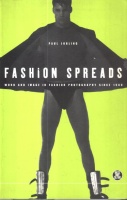kategóriák
- Közlekedés ajánlójegyzék
- Szocreál ajánlójegyzék
- Reklám ajánlójegyzék
- Fotó ajánlójegyzék
- Kínai-japán ajánlójegyzék
- Szentkép ajánlójegyzék
Új árakkal! - Új szentkép ajánlójegyzék II.
- 12 érdekes régiség
 Könyv
Könyv
 Bibliofilia
Bibliofilia
 Régiség
Régiség
 Metszet
Metszet
 Térkép
Térkép
 Fotó
Fotó
 Papírrégiség, Aprónyomtatvány
Papírrégiség, Aprónyomtatvány
 Plakát
Plakát
- Cirkusz
- Modern grafika
- Szocreál
- NER Irodalom
- Egyéb
kosár
üres a kosár
nincs bejelentkezve
Jobling, Paul : Fashion Spreads - Word and Image in Fashion Photography since 1980
- leírás
- további adatok
Series: Dress, Body, Culture.
Doubly tainted by its associations with consumerism and the 'frivolous' world of couture, fashion photography has long been ignored as a serious site for academic study. Yet both the body and dress have proved keenly revealing of gender, race and sexual politics. Further, fashion photography has been transformed by aesthetic concerns, sexual politics and the pleasure of spectatorship - all of which suggest that its iconography represents a rich source for the analysis of how identity is constructed. Exploring representations of the feminine and the masculine body - from super-vamp to super-waif, from buffalo boy to new man - this book considers the social, economic and aesthetic factors that have been instrumental in forging an identity for fashion photography since 1980. Drawing extensively on fashion spreads from Vogue, The Face and Arena, the author takes as his starting point Barthes' axiom that the magazine is 'a machine for making Fashion'. He explores how meaning is constructed in word and image, but he refutes Barthes' claim that the fashion system is a vacuous form of signification. In evaluating the ostensible paradox between sexual objectification and spectatorship, the author also looks at what the depiction of both male and female bodies in fashion spreads reveals about power, knowledge and pleasure. How does the iconography of fashion gratify our desires? Who are these images for - men and women? men or women? Does fashion photography invent role models, or simply satisfy nascent cultural values of beauty and sexual attraction? Why is fashion photography considered a form of 'soft porn' for the delectation of men when women are by far the largest consumers of fashion periodicals? How do the investments of different producers and spectators - male and female, gay and straight, white and non-white - affect the fashion image? In answering these questions and many more, this book represents a significant contribution to the follow.
Doubly tainted by its associations with consumerism and the 'frivolous' world of couture, fashion photography has long been ignored as a serious site for academic study. Yet both the body and dress have proved keenly revealing of gender, race and sexual politics. Further, fashion photography has been transformed by aesthetic concerns, sexual politics and the pleasure of spectatorship - all of which suggest that its iconography represents a rich source for the analysis of how identity is constructed. Exploring representations of the feminine and the masculine body - from super-vamp to super-waif, from buffalo boy to new man - this book considers the social, economic and aesthetic factors that have been instrumental in forging an identity for fashion photography since 1980. Drawing extensively on fashion spreads from Vogue, The Face and Arena, the author takes as his starting point Barthes' axiom that the magazine is 'a machine for making Fashion'. He explores how meaning is constructed in word and image, but he refutes Barthes' claim that the fashion system is a vacuous form of signification. In evaluating the ostensible paradox between sexual objectification and spectatorship, the author also looks at what the depiction of both male and female bodies in fashion spreads reveals about power, knowledge and pleasure. How does the iconography of fashion gratify our desires? Who are these images for - men and women? men or women? Does fashion photography invent role models, or simply satisfy nascent cultural values of beauty and sexual attraction? Why is fashion photography considered a form of 'soft porn' for the delectation of men when women are by far the largest consumers of fashion periodicals? How do the investments of different producers and spectators - male and female, gay and straight, white and non-white - affect the fashion image? In answering these questions and many more, this book represents a significant contribution to the follow.
| állapot: |     |
| kategória: | Könyv > Divat, divattörténet > |
| kategória: | Könyv > Művészet > Fotográfia > |
| kategória: | Könyv > Idegennyelvű könyvek > Angol nyelvű > |
| kiadó: | Berg, (1999) |
| cikkszám / ISBN: | 9781859732281 |
| kötés: | fűzve |
| oldalszám: | 242, [28] (b-w. photos) |
| könyv nyelve: | angol |









 Telefon:
Telefon: E-mail:
E-mail:







